Category:
General musings
Home
Notice: Use of undefined constant the_post_thumbnail - assumed 'the_post_thumbnail' in /home/netscrib/public_html/civilwarcavalry/wp-content/themes/wittenberg/archive.php on line 65

I left Columbus at 7:00 on Friday morning. I got home after ten p.m. tonight. I’ve done more than 7.5 hours of driving today, and I’m beat. I will post about the weekend tomorrow night, including a terrific photo of four bloggers together (Dimitri Rotov, Mannie Gentile, JD, and me). Dimitri has already posted about it, but I will put my two cents’ worth (plus the photos) in tomorrow night when I’m not quite so exhausted.
Scridb filterOn the Road Yet Again…..
Notice: Use of undefined constant the_post_thumbnail - assumed 'the_post_thumbnail' in /home/netscrib/public_html/civilwarcavalry/wp-content/themes/wittenberg/archive.php on line 65

Earlier this year, I made a conscious decision to try to cut back on my Civil War related travel some. Much as I love it, too often I don’t get paid for it, and being self-employed, if I don’t work, I don’t get paid. It’s pretty much that simple. Once Susan got laid off in February, I figured that I had better cut back in order to make sure that I’m maximizing my billable hours and maintaining cash flow. Consequently, I only committed to three out of town events for the entire summer. Two of them happen to be on back-to-back weekends, and the third one is during the third week in August.
The second event is a book signing on Satruday at the commemoration of Corbit’s Charge in Westminster, Maryland (interestingly, the linked article features the guy who accused us of plagiarizing a manuscript that neither of us had ever seen. My guess is that we will cross paths with him there on Saturday, so that will be an interesting interaction). J. D. and I will be signing there pretty much all day on Saturday, so if anyone is in the area, please stop by and say hello.
So, I’m off again tomorrow. I’m driving to Gettysburg early tomorrow morning to meet up with Dave Roth, the publisher of Blue and Gray magazine. We’re going to walk the traditional interpretation of Farnsworth’s Charge for the rebuttal that J. D. and I wrote, and which will be in the next issue. In addition, I’ve written a 3500 word piece on Stuart’s shelling of Carlisle that will also be in the next issue, so we’re going to take a run up to Carlisle so I can show Dave a few sites. Then it’s back to Gettysburg.
Saturday is the book signing. We will stay as long as it’s worth our while to stay. We will then go back to Gettysburg and spend the night there. Then, on Sunday, we’re going to head down to Antietam for some serious battlefield stomping. Ranger Mannie Gentile is going to give us a private tour, and Dimitri Rotov is going to join us there. We’re looking forward to meeting Mannie and Dimitri in person after interacting with them here. I will then head home from Antietam, probably getting back to Columbus pretty late in the evening. So, it’s going to be another banzai run this weekend. I’m then here until August 22…..
Scridb filterPhotos From This Past Weekend
Notice: Use of undefined constant the_post_thumbnail - assumed 'the_post_thumbnail' in /home/netscrib/public_html/civilwarcavalry/wp-content/themes/wittenberg/archive.php on line 65

These are most of the photos that I took in Virginia last weekend. There are a few more, but these are definitely the best of the lot. They appear pretty much in chronological order.
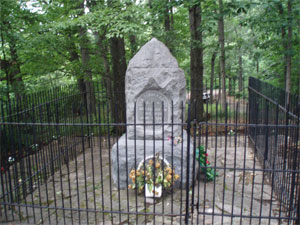
This is the United Daughters of the Confederacy monument to Brig. Gen. Turner Ashby. It sits on the spot where Ashby was killed, which is just outside Harrisonburg. It sits in a remote, tiny park run by the UDC. JMU is building athletic fields right next to it, so it remains to be seen how those fields will impact this handsome monument.
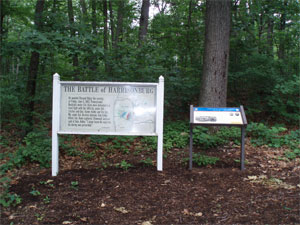
These two signs sit about twenty yards from the Ashby monument.
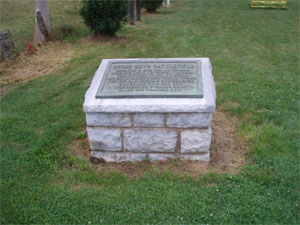
This is the UDC monument to the Battle of Cross Keys. There are a number of interpretive markers around it.
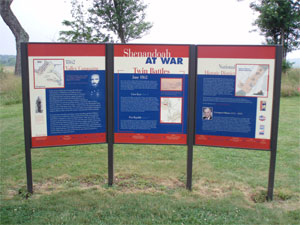
This large, multi-panel marker denotes the battles of Cross Keys and Port Republic, which were fought several days and a few hundred yards apart during Stonewall Jackson’s 1862 Valley Campaign.
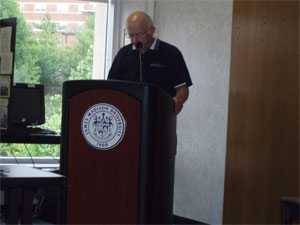
Jeff Wert delivering the opening address at the first session of the conference.
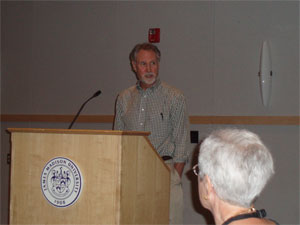
Gordon Rhea delivering the keynote talk on Friday night, which was an excellent overview of the entire Overland Campaign.
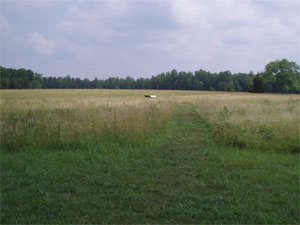
This is the Widow Tapp Field at the Wilderness. I shot this more or less at the location of Robert E. Lee’s headquarters.
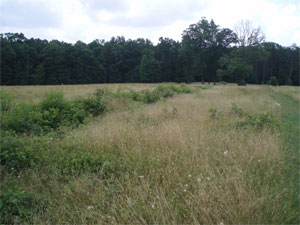
This is a line of Confederate earthworks running through the Widow Tapp Field.
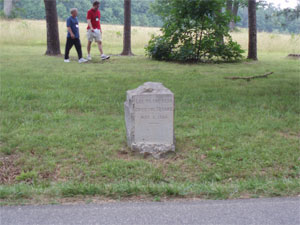
This little monument marks the spot where the famous “Lee to the Rear” marker sits on the edge of the Widow Tapp Field. It’s a nifty little monument, a few yards from the Texas monument.
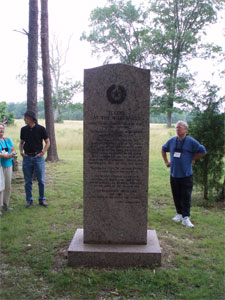
This is the Texas monument. It is made of the same rose marble as all Texas monuments, and sits a few yards from the “Lee to the Rear” marker.
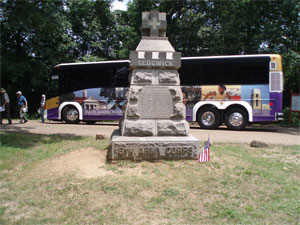
We’ve now moved on to the Spotsylvania Court House battlefield. This monument marks the spot where Maj. Gen. John Sedgwick, the commander of the Sixth Corps, was killed by a Confederate sharpshooter just after saying, “They couldn’t hit an elephant at this range.” Wrong.
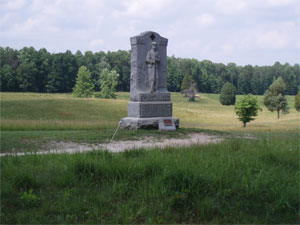
This is one of the tiny handful of monuments on the Spotsylvania battlefield. There are three of them right at the Bloody Angle in the Mule Shoe. This is one of those three, the 15th New Jersey Infantry of the Sixth Corps. Just a few yards away is the marker to the 22-inch thick tree that was felled by being struck by so many bullets during the horrific fighting for the Bloody Angle.
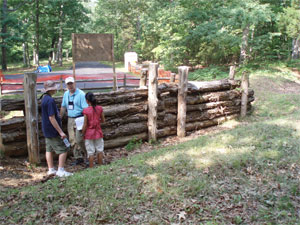
These are re-created Confederate earthworks on Lee’s last line at Spotsylvania. They actually sit astride an actual and exceptionally well-preserved line of Confederate earthworks that runs through the woods you can see in the background.
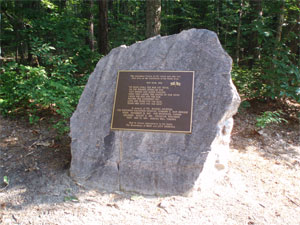
This is the only monument of any sort on the North Anna battlefield, and it’s less than twenty years old. It sits right at the entrance to the county park.
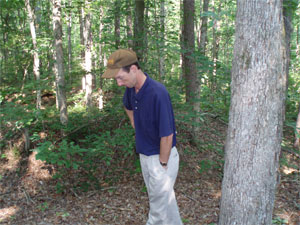
Bobby Krick deep in thought, listening to Gordon discussing Ledlie’s ill-fated attack on the Confederate lines at North Anna.
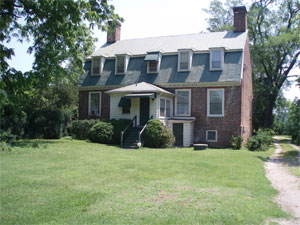
After leaving the North Anna battlefield, we made our way across the Pamunkey River at some of the crossings employed by Grant, made a quick stop at Enon Church to discuss the Battle of Haw’s Shop, and then stopped at this 1725 house. This is the Shelton house. Patrick Henry was married in this house. It was donated to the Park Service last year, and will eventually serve as the visitor center/headquarters for the Park Service’s new Totopotomoy Creek unit. It’s not yet open to the public.

Bobby Krick, Gordon Rhea, and yours truly on the battlefield at Cold Harbor.
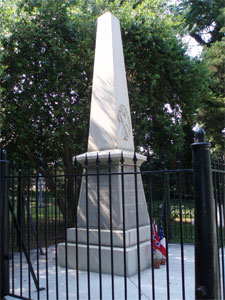
Our final stop was a quick visit to the Yellow Tavern battlefield. This is the monument to Jeb Stuart that marks the spot where he received his mortal wound. It’s a favorite monument of mine in what Bobby likes to describe as the “postage stamp park”, describing the tiny oasis in the middle of a subdivision where the monument stands.
That’s it. This was, as they say, a busman’s holiday for me. I had a fabulous time. How could you not have a fabulous time with the likes of Jeff Wert, Gordon Rhea, and Bobby Krick?
Scridb filterHome Again
Notice: Use of undefined constant the_post_thumbnail - assumed 'the_post_thumbnail' in /home/netscrib/public_html/civilwarcavalry/wp-content/themes/wittenberg/archive.php on line 65

After six very long hours of driving, I’m home. It was well into the 90’s all day as I was driving, which just adds to the fatigue. We will post photos from the trip tomorrow night.
There’s a very good, authentic New York-style bagel place across the street from the hotel where I stayed in Harrisonburg. I had breakfast there all three mornings I was in Harrisonburg. This morning, I had my breakfast and lingered for a few moments to finish reading the USA Today. When I finished the paper, I got up to leave. After busing my tray, I noticed a fellow wearing a t-shirt from the Trevilian Station Battlefield Foundation, so I jokingly said, “Nice shirt.”
The fellow said thanks, and then did one of those deep double-takes. He said, “You’re Eric Wittenberg, aren’t you?”
Now it was my turn to be shocked. I’m not used to be recognized like that, especially not in a random encounter like that far from home. I said that I was, and he indicated that I had met him at the 140th reenactment of the Battle of Trevilian Station in 2004, and that I had actually been standing next to him when he bought the shirt. That blew me away. I meet so many people doing this that it’s almost impossible to remember most of them. I didn’t recognize or remember him at all, so I did not know what to say. I quickly changed the topic and we chatted a bit. He and his wife were on their way to Vicksburg, and had spent the night in Harrisonburg.
Talk about a coincidence…..
It made my day. It made that miserable drive a little more bearable.
Scridb filterWeekend Wrap-Up
Notice: Use of undefined constant the_post_thumbnail - assumed 'the_post_thumbnail' in /home/netscrib/public_html/civilwarcavalry/wp-content/themes/wittenberg/archive.php on line 65

To say the least, it’s been a LONG weekend.
Here’s what the last two days have entailed. We will get some photos posted over the next couple of days, once I get home.
The bus picked us up at 7:45 AM yesterday morning. We headed out to the Wilderness. It’s a little over two hours from Harrisonburg to the Wilderness. The ride went quickly. Gordon Rhea did a lot of introduction to the campaign and I did a little on the cavalry.
We got to the Wilderness and unloaded. We walked the Saunders Field fights and then headed back out. Since we were tight on time, we drove from there down to the Widow Tapp Farm, site of the famous “Lee to the rear” incident. We walked the trail there, and Gordon did quite a bit of interpretation. The rest of the Wilderness interpretation was done from the bus. It included seeing the spot where Longstreet was wounded, the site where Wadsworth was killed, and several other sites. From there, we went to the visitor center at Chancellorsville for a boxed lunch. While there, I had a chance to visit with Mac Wycoff, who is a ranger and historian there.
We then drove past the Chancellor house site and down the Brock Road to Todd’s Tavern. When we got there, I interpreted the cavalry fight that occurred there and discussed the violent confrontation between Meade and Sheridan that triggered the May Richmond raid. From there, we went on to Spotsylvania Court House. We unloaded the bus at the Sedgwick monument (the spot where Uncle John got popped). Gordon interpreted the opening of the battle, and then we walked out and toured the Laurel Hill loop. It was beastly hot, and it was a long walk. From there, we hiked Upton’s attack against the west side of the Mule Shoe salient, which is a short but neat walk through the woods that ends at one of the few monuments on the battlefield at Spotsylvania. Next came the Bloody Angle assault, including walking the trail for Hancock’s assault. When we finished that, we did a final long hike of Lee’s last line, which features some absolutely spectactular earthworks through the woods. That was our last stop at Spotsylvania, although we saw a few more pertinent sites, such as Burnside’s attack against the Mule Shoe, from the bus. We finished the day’s touring with a stop at Massaponax Church. We must have walked four or five miles yesterday in nearly 90 degree heat, and boy, was I tired. We checked into the hotel and then had a nice dinner at a nearby Pizzeria Uno. I didn’t have a whole lot of trouble falling asleep last night.
This morning, it was another early start. We drove down to the nifty county park at the North Anna site. Gordon did more interpretation along the way, pointing out interesting sites from the movement south, and I showed the spot where Sheridan’s raid turned off the Telegraph Road to head toward Beaver Dam Station, which was a stop on the Virginia Central Railroad. We got to the North Anna park and Bobby Krick joined us. The group walked the trail to the apex of Lee’s position. For those who have never visited this site, these are, without doubt, the best earthworks I’ve ever seen in Virginia. They’re just spectacular, and they’re extremely well preserved. After reaching the apex, there’s a side trail you can take that takes you to an overlook of Ox Ford, and you can hear the North Anna rushing 100 feet below. The place reminded me a great deal of Ball’s Bluff, with the notable exception being that there were no earthworks at Ball’s Bluff and the Potomac is a bit wider and deeper than the North Anna. 🙂
After hiking back out of there, we then loaded back up into the buses. We went from there to see some spots along the Pamunkey River, where Grant crossed the river to head toward Cold Harbor. From there, we went to Haw’s Shop. Unfortunately, Enon Church, which is an active congregation, had services in session when we got there, and the parking lot was completely full, so I had to interpret the battle from the bus. We then continued another mile or so along the Atlee Station Road on to the Stafford house–where Patrick Henry was married–to see the Totopotomoy Creek actions of May 28 and 29. The National Park Service just acquired this house and its surrounding grounds, which include some impressive earthworks thrown up by men of Winfield Scott Hancock’s Second Corps of the Army of the Potomac, last year when the elderly owner of the property died, and it’s going to serve as NPS headquarters for a new unit on the Totopotomoy Creek fighting. I’d never seen the Stafford house, so it was very cool.
From there, we went to have lunch on the Cold Harbor battlefield. After lunch, it was now in the 90’s and quite warm, with building humidity. We went to the little visitor’s center there (where I finally got around to buying a copy of Brian Burton’s book on the Seven Days, which I’d been meaning to do for some time) and then started interpreting the battle. We walked the big loop from the visitor’s center through the woods to Bloody Run and then back to the second ravine, which Gordon named Muddy Run. From there, we went to the Adams farm site, which actually is two different battlefields in one. It was the right end of the Union line in the Gaine’s Mill fight of 1862 and also was Hancock’s sector during Cold Harbor. The interesting thing about this site is that the axis was different for each. The Gaine’s Mill fight was a north/south fight, while the Cold Harbor fight covered the same ground from an east/west axis. I’d never seen this field before, and it’s in private hands. But for Bobby Krick, we wouldn’t have been able to get on the field. After loading back up and a potty stop at the Cold Harbor visitor center, we went out to the Stuart monument at Yellow Tavern. I interpreted the Battle of Yellow Tavern there, and that was the end of the day’s touring. Bobby left us–he lives near there–and we loaded up the bus and headed back to the Valley. After dinner, it was back to Harrisonburg and this hotel.
I’ve probably hiked between eight and nine miles in the last two days in some beastly heat. Once again, I’m beat. Tomorrow morning is the closing session, a farewell luncheon, and then I get to drive 7 hours home to Columbus. I should be home by this time (9:00) tomorrow night. My own bed is going to look good.
After discussing things with Gordon and Bobby, I’ve decided to tackle a book project that covers the cavalry operations of May 27-30, which will feature the Battle of Haw’s Shop and the taking of the critical road intersection at Old Cold Harbor. They’ve both offered to help, and I think it’s going to be an interesting project. Stay tuned.
For now, though, I’m tired.
Scridb filterWhy I’m in the Shenandoah Valley
Notice: Use of undefined constant the_post_thumbnail - assumed 'the_post_thumbnail' in /home/netscrib/public_html/civilwarcavalry/wp-content/themes/wittenberg/archive.php on line 65

As I said earlier today, I’m here for the annual conference of the Shenandoah Civil War Associates. The program is administered through James Madison University and based there. I drove in yesterday, a lovely 7 hour drive through BFE in West Virginia. Last night we had a board meeting to plan next year’s program (which will be April 1-9, 1865) and an absolutely incredible meal.
This year’s program is the Overland Campaign of 1864. Faculty for the symposium are Gordon Rhea, Jeff Wert, Robert E. L. Krick (also known as Krick the Younger) and yours truly. Today was a partial day, mostly to introduce the campaign. Tomorrow and Sunday are battlefield stomping days. Tomorrow, we cover the Wilderness and Spotsylvania Court House. Sunday, we cover North Anna, Cold Harbor, and will make a half hour or so stop at Yellow Tavern. We return to Harrisonburg on Sunday night. There’s a final speaker on Monday morning, a panel discussion, and a farewell lunch. I will head out to drive home about 1:30 or so, meaning that I will get home about 8:30, undoubtedly exhausted. It’s supposed to be 95 on Sunday, so it’s going to be a long day in some pretty beastly heat.
This morning was free time for me, so I took advantage of it. I got up, had breakfast and then visited three different battlefields. Not far from my hotel is the site of the June 6, 1862 Battle of Harrisonburg, where Turner Ashby was killed. There’s a nifty little site there, with a couple of interpretive markers and a monument to Ashby on the spot where he bought the farm.
I left there and drove the 15 or so miles down to Port Republic, meaning that I visited the Cross Keys and Port Republic battlefields. I was alone, there’s not much interpretation out there, and nobody would ever call me an expert on Jackson’s 1862 Valley Campaign. I figured out what I could–not terribly much–enjoyed the gorgeous landscape, and headed back.
The program began at 1:00. Gordon was supposed the be the first speaker, at 1:30. However, Gordon had to be in court in St. Louis today (for those who don’t know, he’s also a lawyer), so the schedule was juggled. Jeff Wert gave a talk on the state of the armies in 1864, we had a booksigning session, and then I did a talk on cavalry operations in the Overland Campaign.
Tonight, there was a dinner. Poor Gordon–he got to Dulles and discovered that his puddle jumper flight to the Shenandoah Regional Airport had been canceled, so he had to rent a car and drive like the wind to get here by 7:30. He then gave a great overview of the entire campaign that was very useful. Not bad for a guy who’s been up since 4:00 AM.
Tomorrow morning, it’s up at 6:00 to be ready to load up the bus at 7:45. Unfortunately, Jeff Wert won’t be able to join us. His lovely wife Gloria is ill, so Jeff will be going home tomorrow instead of coming with us. Bobby Krick will join up with us on Sunday, tomorrow is Gordon and me. Trust me when I tell you that it be MAINLY Gordon. 🙂
Three battlefields today. Two (three, actually, since we’re having lunch at the Chancellorsville visitor’s center) tomorrow. Three or more on Sunday. It just doesn’t get any better than this. And, as Steve Martin used to say, “I get paid for doing this….” 🙂
I will try to post something tomorrow night from our hotel in Fredericksburg.
Scridb filterBada Bing
Notice: Use of undefined constant the_post_thumbnail - assumed 'the_post_thumbnail' in /home/netscrib/public_html/civilwarcavalry/wp-content/themes/wittenberg/archive.php on line 65

For the last eight years, I’ve been a dedicated fan of The Sopranos. I’ve seen all 86 episodes at least once. I’ve closely followed the travails of Tony Soprano and his two families, his personal family and his Mafia family. I believe that The Sopranos is quite possibly the finest television drama ever, as do many critics.
Tonight was the final new episode of the show. It was a moment that I’ve both looked forward to and dreaded all at the same time. In typical David Chase fashion, some loose ends were tied up, but many were left hanging. We will never know what happened to the Russian mobster from the Pine Barrens. We don’t know whether Sil will ever recover from his wounds. We don’t know whether Tony got indicted. We will never know whether the mysterious looking guy who goes into the men’s room at the end of the final epiosde was there to kill Tony. We will never get the answers to a lot of questions. But it wouldn’t have been an appropriate ending to this great show otherwise.
Having said that, I have to say that I was really glad to see Little Carmine step up the plate and broker a deal to end the war between the New York and New Jersey families. And Phil Leotardo definitely got what he deserved. Good riddance–if ever someone deserved to be whacked it was Phil.
The only thing missing was the ducks. It would have been appropriate if Tony had seen the ducks again while searching the winter sky a few minutes before the end of the episode. It would have brought the story full circle. But alas, there were no ducks to be seen.
I will miss The Sopranos. As a family, they put the fun in dysfunctional. 🙂 In the end, though, this great show was always all about family. So, it’s appropriate that it ended that way: with Tony’s family all together at the dinner table. What happens to them after that, we will never know. And perhaps it’s best that way.
Scridb filterJust to Clarify….
Notice: Use of undefined constant the_post_thumbnail - assumed 'the_post_thumbnail' in /home/netscrib/public_html/civilwarcavalry/wp-content/themes/wittenberg/archive.php on line 65

I want to make this very clear, and I want there to be absolutely no ambiguity about this, so I will state it very specifically:
My post last night was NOT intended to stir up the whole hornet’s nest of amateur vs. professional historians. I don’t want to get into that–we’ve beaten that poor horse to death here in the past, and we’re not going there now. This is not a broad brushstrokes sort of thing. It’s about one person and comments made by that one person.
To repeat: We are NOT going to re-open the amateur vs. professional can of worms in this discussion. Any comments that do will be deleted.
Scridb filterForty Years Ago Today
Notice: Use of undefined constant the_post_thumbnail - assumed 'the_post_thumbnail' in /home/netscrib/public_html/civilwarcavalry/wp-content/themes/wittenberg/archive.php on line 65

Forty years ago today, the Israel Defense Forces launched the ultimate blitzkrieg. In a matter of a few hours, the Israeli Air Force, in a lightning surprise preemptive strike, destroyed more than 400 Arab aircraft, with the majority of them being destroyed on the ground of their airbases. From that moment forward, the Israelis had virtually uncontested control of the skies. The Israeli army not only defeated three Arab countries in just six days, it completely humiliated Egypt, Syria, and Jordan. Hoping to gain a buffer zone to protect it from Arab fedayeen raids and to give the country a protective buffer from hostile enemies surrounding the country of Israel, the IDF seized control of the Golan Heights from Syria, the West Bank, including Jerusalem, from Jordan, and the Gaza Strip and the Sinai Desert from Egypt. Along the way, the Israelis proved that Soviet weapons were not so fearsome as portrayed, and they also demonstrated the superiority of Western ordnance and weaponry. With their stunning victory, the Israelis more than doubled the total land mass of the State of Israel, gave it buffers from the hostile Arab states surrounding it, and took on a huge Palestinian refugee population in the process, thus sewing the seeds for decades of political misery.
The scope of the Israeli victory was stunning, as was the absolute nature of the Arab defeat, which was complete and utter. It was, without doubt, the IDF’s finest moment.
At the same time, Israel’s greatest moment of triumph has proved to be its biggest problem. For one thing, the victory in the Six Day War made the IDF overconfident, and it was caught by surprise in October 1973 and nearly defeated by determined attacks by Syria and Egypt. Only hard, determined fighting by a desperate IDF kept Prime Minister Golda Meir from employing tactical nuclear weapons. That overconfidence continues to this day; one need only study the debacle of the Israeli invasion of Lebanon last summer to try to silence Hezbollah for an example.
Further, the occupied territories have been nothing but a thorn in the side of one Israeli regime after another. Two intifadas have followed, terrorism has become standard operating procedure, radical Islam has gained a foothold, and the great Israeli victory made the Yom Kippur War of 1973 inevitable. In a stunning juxtaposition, that great moment of triumph for the Israelis has turned into the biggest thorn in their collective side and has caused years and years of strife. While Egypt and Jordan eventually made peace with Israel, it took the Yom Kippur War for it to happen, and it cost the lives of Anwar Sadat and Yitzhak Rabin, both assassinated by radical citizens of their own countries opposed to peacemaking. It has made Syria an even more intransigent enemy of Israel, and has caused organizations like Hamas–sworn to the destruciton of the Jewish state–to gain extensive popular following among the Palestinian refugees and sympathy on the rest of the Arab street. The phenomenon of the suicide bomber has its roots in the conflict over the occupied territories. One might even say that the attacks of 9/11 have their roots in the Six Day War, since radical Islam’s use of terrorism as a weapon stems directly from the loss of the occupied territories.
Thus, the Six Day War, which provides some really useful and remarkable tactical lessons for the military historian, also provides a classic study of how war impacts geopolitics, and that those geopolitics can have far-reaching and unforeseen consequences.
Scridb filterThe Stuff That Turns Up Just Amazes Me….
Notice: Use of undefined constant the_post_thumbnail - assumed 'the_post_thumbnail' in /home/netscrib/public_html/civilwarcavalry/wp-content/themes/wittenberg/archive.php on line 65

The primary source material from the Civil War that continues to surface never ceases to amaze me. It also makes me wonder what else like it remains out there, unknown and languishing….
As you may recall, I posted three consecutive posts on the significance of the Battle of Chancellorsville on May 1-3, commemorating the anniversary of the battle. The third and final post discussed the similarities between the Battles of Chancellorsville and Gettysburg, and suggested that nobody can ever truly understand the Battle of Gettysburg without having a solid understanding of the Battle of Chancellorsville. The last comment received on that post, which was posted on May 22, was by a fellow named J. Wistar “Pete” Huey, III. Pete wrote, “I`ve got a file cabinet full of great grandfather Pennock`s papers, correspondence, etc.. One of these days I hope to get it all in some semblance of order and donate it to the Chester County Historical Society.”
Needless to say, that got my attention. I chronicled the charge of the 8th Pennsylvania Cavalry at Chancellorsville in my book The Union Cavalry Comes of Age: Hartwood Church to Brandy Station, 1863 in detail, and I’d done a great deal of research into the charge. Pennock Huey wrote a small volume on the charge that was published in 1885 (I own a first edition as well as a replica reprint of the second edition), but I was completely unaware of any colleciton of Huey’s papers anywhere. I recognized that locating a set of Huey papers was a significant find, as Huey was breveted to brigadier general of volunteers and commanded a brigade during the Gettysburg Campaign. Any papers would be useful for J. D.’s and my forthcoming three-volume study of cavalry operations during the Gettysburg Campaign.
I wrote to Pete, and we’ve engaged in an exchange of e-mails. Here’s how Pete described what he’s got: “Most of what I have is correspondence relating to his book, to and from various participants in the ‘Charge’ before the book was published, while he was working on it. I`ve also got a fair amount of his military paper work and four gold coins he kept sewn into the hem of his trousers while a POW at Roper Military Prison in Charleston. After the war he had them made into cufflinks, which I wear from time to time when I don my ‘formal’ kilt getup. I`ve also got his ‘excommunication papers’ from the Society of Friends, who took issue with his taking up arms, and other stuff I`d have to actually examine to describe. As mentioned, it about fills a file cabinet and is in no order at all. Quite a bit is in the form of packets of letters tied in ribbon, some of which I haven`t read.”
Wow. Talk about a find….
Biographical information on Huey is almost impossible to find. I’ve tried, and I wasn’t able to find much of anything of any substance. I had no idea that he was a Quaker until I read Pete’s e-mail to me.
The upshot is that I’ve asked Pete to give me a couple of paragraphs of biographical information on Huey, and then I will do one of my “forgotten cavalrymen” profiles of him here once I get that material. I’m also re-visiting the Chancellorsville episode. J. D. and I are going to update my prior work by including some of Pete’s stuff (with his permission, of course) for an article for one of the magazines, and pertinent information will be incorporated into our three-volume study of the cavalry in the Gettysburg Campaign. So far as I can tell, I will be the first person outside the family to even see any of this material, which is just mind-boggling. I’m looking forward to it.
So, if this stuff is out there, what else is lurking in attics and basements?
Scridb filterNotice: Undefined index: id in /home/netscrib/public_html/civilwarcavalry/wp-content/themes/wittenberg/footer.php on line 8
Notice: Undefined index: id in /home/netscrib/public_html/civilwarcavalry/wp-content/themes/wittenberg/footer.php on line 8
Notice: Undefined index: std in /home/netscrib/public_html/civilwarcavalry/wp-content/themes/wittenberg/footer.php on line 8
Notice: Undefined index: id in /home/netscrib/public_html/civilwarcavalry/wp-content/themes/wittenberg/footer.php on line 8
Notice: Undefined index: id in /home/netscrib/public_html/civilwarcavalry/wp-content/themes/wittenberg/footer.php on line 8
Notice: Undefined index: std in /home/netscrib/public_html/civilwarcavalry/wp-content/themes/wittenberg/footer.php on line 8
Notice: Undefined index: id in /home/netscrib/public_html/civilwarcavalry/wp-content/themes/wittenberg/footer.php on line 8
Notice: Undefined index: id in /home/netscrib/public_html/civilwarcavalry/wp-content/themes/wittenberg/footer.php on line 8
Notice: Undefined index: std in /home/netscrib/public_html/civilwarcavalry/wp-content/themes/wittenberg/footer.php on line 8
Notice: Undefined index: id in /home/netscrib/public_html/civilwarcavalry/wp-content/themes/wittenberg/footer.php on line 8
Notice: Undefined index: id in /home/netscrib/public_html/civilwarcavalry/wp-content/themes/wittenberg/footer.php on line 8
Notice: Undefined index: std in /home/netscrib/public_html/civilwarcavalry/wp-content/themes/wittenberg/footer.php on line 8
Notice: Undefined index: id in /home/netscrib/public_html/civilwarcavalry/wp-content/themes/wittenberg/footer.php on line 8
Notice: Undefined index: id in /home/netscrib/public_html/civilwarcavalry/wp-content/themes/wittenberg/footer.php on line 8
Notice: Undefined index: std in /home/netscrib/public_html/civilwarcavalry/wp-content/themes/wittenberg/footer.php on line 8
Notice: Undefined index: id in /home/netscrib/public_html/civilwarcavalry/wp-content/themes/wittenberg/footer.php on line 8
Notice: Undefined index: id in /home/netscrib/public_html/civilwarcavalry/wp-content/themes/wittenberg/footer.php on line 8
Notice: Undefined index: std in /home/netscrib/public_html/civilwarcavalry/wp-content/themes/wittenberg/footer.php on line 8
Notice: Undefined index: id in /home/netscrib/public_html/civilwarcavalry/wp-content/themes/wittenberg/footer.php on line 8
Notice: Undefined index: id in /home/netscrib/public_html/civilwarcavalry/wp-content/themes/wittenberg/footer.php on line 8
Notice: Undefined index: std in /home/netscrib/public_html/civilwarcavalry/wp-content/themes/wittenberg/footer.php on line 8
Notice: Undefined index: id in /home/netscrib/public_html/civilwarcavalry/wp-content/themes/wittenberg/footer.php on line 8
Notice: Undefined index: id in /home/netscrib/public_html/civilwarcavalry/wp-content/themes/wittenberg/footer.php on line 8
Notice: Undefined index: std in /home/netscrib/public_html/civilwarcavalry/wp-content/themes/wittenberg/footer.php on line 8
Notice: Undefined index: id in /home/netscrib/public_html/civilwarcavalry/wp-content/themes/wittenberg/footer.php on line 8
Notice: Undefined index: id in /home/netscrib/public_html/civilwarcavalry/wp-content/themes/wittenberg/footer.php on line 8
Notice: Undefined index: std in /home/netscrib/public_html/civilwarcavalry/wp-content/themes/wittenberg/footer.php on line 8
Notice: Undefined index: id in /home/netscrib/public_html/civilwarcavalry/wp-content/themes/wittenberg/footer.php on line 8
Notice: Undefined index: id in /home/netscrib/public_html/civilwarcavalry/wp-content/themes/wittenberg/footer.php on line 8
Notice: Undefined index: std in /home/netscrib/public_html/civilwarcavalry/wp-content/themes/wittenberg/footer.php on line 8
Notice: Undefined index: id in /home/netscrib/public_html/civilwarcavalry/wp-content/themes/wittenberg/footer.php on line 8
Notice: Undefined index: id in /home/netscrib/public_html/civilwarcavalry/wp-content/themes/wittenberg/footer.php on line 8
Notice: Undefined index: std in /home/netscrib/public_html/civilwarcavalry/wp-content/themes/wittenberg/footer.php on line 8
Notice: Undefined index: id in /home/netscrib/public_html/civilwarcavalry/wp-content/themes/wittenberg/footer.php on line 8
Notice: Undefined index: id in /home/netscrib/public_html/civilwarcavalry/wp-content/themes/wittenberg/footer.php on line 8
Notice: Undefined index: std in /home/netscrib/public_html/civilwarcavalry/wp-content/themes/wittenberg/footer.php on line 8
Notice: Undefined index: id in /home/netscrib/public_html/civilwarcavalry/wp-content/themes/wittenberg/footer.php on line 8
Notice: Undefined index: id in /home/netscrib/public_html/civilwarcavalry/wp-content/themes/wittenberg/footer.php on line 8
Notice: Undefined index: std in /home/netscrib/public_html/civilwarcavalry/wp-content/themes/wittenberg/footer.php on line 8
Notice: Undefined index: id in /home/netscrib/public_html/civilwarcavalry/wp-content/themes/wittenberg/footer.php on line 8
Notice: Undefined index: id in /home/netscrib/public_html/civilwarcavalry/wp-content/themes/wittenberg/footer.php on line 8
Notice: Undefined index: std in /home/netscrib/public_html/civilwarcavalry/wp-content/themes/wittenberg/footer.php on line 8
Notice: Undefined index: id in /home/netscrib/public_html/civilwarcavalry/wp-content/themes/wittenberg/footer.php on line 8
Notice: Undefined index: id in /home/netscrib/public_html/civilwarcavalry/wp-content/themes/wittenberg/footer.php on line 8
Notice: Undefined index: std in /home/netscrib/public_html/civilwarcavalry/wp-content/themes/wittenberg/footer.php on line 8
Notice: Undefined index: id in /home/netscrib/public_html/civilwarcavalry/wp-content/themes/wittenberg/footer.php on line 8
Notice: Undefined index: id in /home/netscrib/public_html/civilwarcavalry/wp-content/themes/wittenberg/footer.php on line 8
Notice: Undefined index: std in /home/netscrib/public_html/civilwarcavalry/wp-content/themes/wittenberg/footer.php on line 8
Notice: Undefined index: id in /home/netscrib/public_html/civilwarcavalry/wp-content/themes/wittenberg/footer.php on line 8
Notice: Undefined index: id in /home/netscrib/public_html/civilwarcavalry/wp-content/themes/wittenberg/footer.php on line 8
Notice: Undefined index: std in /home/netscrib/public_html/civilwarcavalry/wp-content/themes/wittenberg/footer.php on line 8
Notice: Undefined index: id in /home/netscrib/public_html/civilwarcavalry/wp-content/themes/wittenberg/footer.php on line 8
Notice: Undefined index: id in /home/netscrib/public_html/civilwarcavalry/wp-content/themes/wittenberg/footer.php on line 8
Notice: Undefined index: std in /home/netscrib/public_html/civilwarcavalry/wp-content/themes/wittenberg/footer.php on line 8
Notice: Undefined index: id in /home/netscrib/public_html/civilwarcavalry/wp-content/themes/wittenberg/footer.php on line 8
Notice: Undefined index: id in /home/netscrib/public_html/civilwarcavalry/wp-content/themes/wittenberg/footer.php on line 8
Notice: Undefined index: std in /home/netscrib/public_html/civilwarcavalry/wp-content/themes/wittenberg/footer.php on line 8
Notice: Undefined index: id in /home/netscrib/public_html/civilwarcavalry/wp-content/themes/wittenberg/footer.php on line 8
Notice: Undefined index: id in /home/netscrib/public_html/civilwarcavalry/wp-content/themes/wittenberg/footer.php on line 8
Notice: Undefined index: std in /home/netscrib/public_html/civilwarcavalry/wp-content/themes/wittenberg/footer.php on line 8
Notice: Undefined index: id in /home/netscrib/public_html/civilwarcavalry/wp-content/themes/wittenberg/footer.php on line 8
Notice: Undefined index: id in /home/netscrib/public_html/civilwarcavalry/wp-content/themes/wittenberg/footer.php on line 8
Notice: Undefined index: std in /home/netscrib/public_html/civilwarcavalry/wp-content/themes/wittenberg/footer.php on line 8








 Back to top
Back to top Blogs I like
Blogs I like 